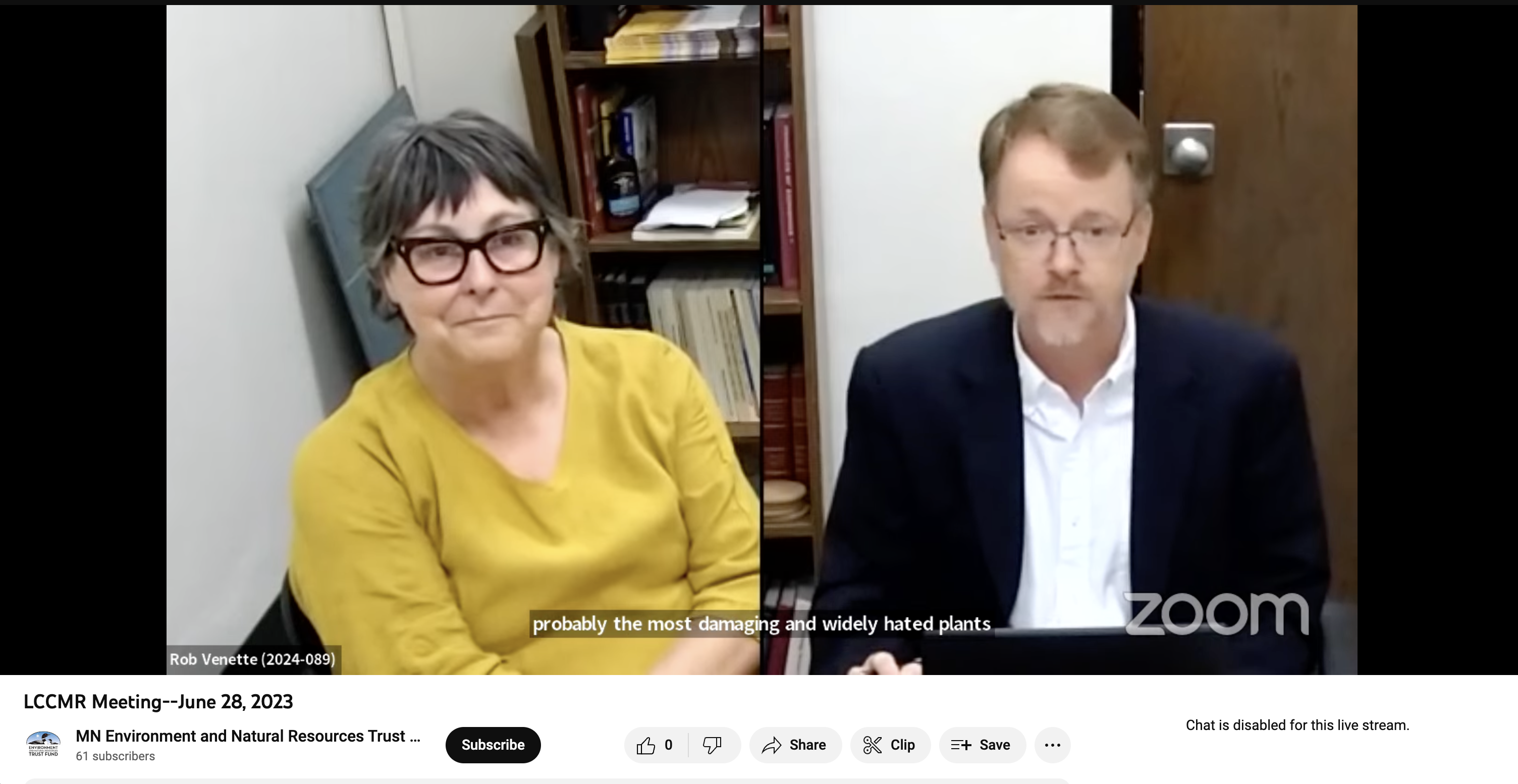June 28, 2023
Since the establishment of the Minnesota Invasive Terrestrial Plants and Pests Center (MITPPC) in 2014, we have received significant financial support from the Environment and Natural Resources Trust Fund (ENRTF) as recommended by the Legislative and Citizen Commission for Minnesota Resources (LCCMR).
This year, MITPPC requested $7 million to fund up to 15 new, high-priority terrestrial invasive species research projects that would begin in 2025 and 2026. This was in answer to LCCMR's 2024 call for proposals.
To demonstrate this need, MITPPC director, Dr. Robert Venette, and Associate Director, Heather Koop, appeared at a hearing on Wednesday, June 28, 2023. Dr. Venette highlighted MITPPC's impacts, described why continued support from the LCCMR is essential, and answered commission member questions.
Watch the replay of the presentation. It starts at 4:00:18 and lasts about 20 minutes including questions.

The following is an edited transcript of the presentation.
We’re here to explain what MITPPC is and why your continued support is essential to protect Minnesota’s lands from invasive species, like buckthorn, emerald ash borer, and oak wilt.
MITPPC was created by the legislature in 2014. Our purpose is to discover new techniques and technologies that will protect Minnesota’s forests, prairies, wetlands, and agriculture from harmful weeds, worms, insects, and diseases that are not native to Minnesota. This is a huge remit given the numerous invasive species that can affect any one of these ecosystems.
MITPPC prioritizes research on those species that pose the greatest threat to the state. We use this prioritized list for our annual grant program that runs alongside LCCMR’s RFP. In fact, your RFP asks researchers who want to work on terrestrial invasive species to apply to us.
The proposals that we receive go through two rounds of peer review to ensure the highest quality science that will make a difference on the ground. MITPPC also helps connect researchers with potential implementation partners for the planning and conduct of project work. We also put a major effort into communications to ensure that people across the state are aware of the good work we are doing and can use project results.
MITPPC has been hugely successful thanks to the previous support of the LCCMR. To date, we have funded 52 research projects involving 96 researchers and another 52 external partners. The work has yielded exciting discoveries that are making tangible differences to invasive species management across the state.
Let’s consider two examples.
Buckthorn is one of the most damaging and widely hated plants in the state. Our teams have shown that goats by themselves are not a silver bullet. However, we see promise with a rust fungus that might provide biological control, particularly for glossy buckthorn. Interestingly, you can read more about that project on the cover of the Star Tribune today.
More immediately, our teams have shown that planting native plants to compete with buckthorn for light substantially increases the success of buckthorn management. Our teams are working with the Department of Natural Resources, the Board of Water and Soil Resources, and the Shakopee-mdewakanton Sioux to implement these results more broadly.
Buckthorn is also the overwintering host of soybean aphid, our second example. Soybean aphid remains the most damaging insect pest on the 7 million acres of soybean grown in the state. It drives considerable insecticide use. Managing buckthorn will help to reduce pressure from soybean aphid, but more directly, MITPPC teams have developed resistant soybeans and found a parasitic wasp that can work together to prevent aphid outbreaks without the need for insecticides. Our goal is to protect the environment and provide growers with workable tools. We thank Minnesota’s soybean growers for their enthusiasm for these projects.
These stories are just the tip of the iceberg.
The funding that we have requested will allow us to develop more solutions for the terrestrial invasive species problems in the state through two more calls for proposals. If funded in full, we could support up to 15 new research projects and could expand the number of species that are eligible for research.
In conclusion, we know that well over 300 terrestrial invasive species occur in the state and cost residents over $3 billion annually. Our full request is for 1/10 of 1% of the damage that these species will cause over the next two years. This is an investment that seems more than appropriate for the scope of the problem. We are excited to expand MITPPC’s important work that is benefiting the entire state.
We thank you, commission members, who have been involved in the many successes of our Center.
Resources
- Replay of MITPPC to the LCCMR (starts at 4:00:18 and lasts about 20 minutes)
- About MITPPC
- Highlights of MITPPC impacts
- Funded research projects by species